

 It's called the AdoquÍn for the six-sided bricks that pave the section
of Av. Perez Gasga that parallels the beach of the Bahia Principal. This
pedestrian mall is the tourist heart of Puerto and as the closest thing
we have to a zócalo, or main plaza, it's soul, too. Over the years it
has begun to show signs of wear from the rains and other onslaughts of
both Nature and Man. So it was welcome news that the federal government
had allocated funds to remodel the AdoquÍn, replacing the bricks and
installing benches, decorative lighting and planters.
It's called the AdoquÍn for the six-sided bricks that pave the section
of Av. Perez Gasga that parallels the beach of the Bahia Principal. This
pedestrian mall is the tourist heart of Puerto and as the closest thing
we have to a zócalo, or main plaza, it's soul, too. Over the years it
has begun to show signs of wear from the rains and other onslaughts of
both Nature and Man. So it was welcome news that the federal government
had allocated funds to remodel the AdoquÍn, replacing the bricks and
installing benches, decorative lighting and planters.
Unfortunately that was a year and a half ago. The project had become mired in the ongoing territorial dispute over which county - San Pedro Mixtepec or Santa María Colotepec - owns Puerto Escondido. Finally last month, fed up with the refusal of Colotepec's president to allow the project and appalled that the funds would be lost - along with the opportunity to beautify the AdoquÍn, an economic resource that benefits all the surrounding communities - the people of Puerto Escondido came together to get the work going.
On Sept. 20, following an impassioned community meeting, young and old, men and women, fishermen and taxi drivers, business owners and teachers, market ladies and professionals, worked into the wee hours removing the old adoquins in a joyous and festive expression of their affection for Puerto Escondido.
The following day, the workers contracted to carry out the remodeling began to lay new bricks. At this writing, the work was progressing. If all goes well, the Adoquin will have a bright new face to welcome its visitors by the time the Fiestas of November begin.
So, please forgive the inconvenience; the businesses on the AdoquÍn remain open to serve you (including the offices and gallery of your humble correspondent) and committed to restoring the beauty that the heart and soul of Puerto deserves.
It's how Puerto tunes up for the high season, presenting a program of events that showcase the many attractions and activities that make our corner of the world a terrific tourist destination. Here are some of the highlights (though some dates are still provisional): The International Sailfish Tournament is slated for Nov. 16 - 18. Prizes this year include: a Nissan Sentra for first place; a Nissan pickup for second and a Nissan Tsuru GS1 for third. Registration fee is $7,000 pesos per boat.
The Coast Festival of Dance will take place Nov. 17 and 18 and the International Surf Tournament is planned for the weekend of Nov. 23 - 25,
Still to be confirmed is the return of Motorcross to Puerto Nov. 10 and 11.
 On the first of this month, 40 young people from Puerto Escondido began
their higher education at the brand-new Puerto Escondido campus of the
University of the Sea (UMAR). The campus is steadily taking shape out
past the gas plant on the road to San Pedro Mixtepec.
On the first of this month, 40 young people from Puerto Escondido began
their higher education at the brand-new Puerto Escondido campus of the
University of the Sea (UMAR). The campus is steadily taking shape out
past the gas plant on the road to San Pedro Mixtepec.
This will be the third campus of UMAR, joining UMAR, Puerto Angel, which has a focus on oceanography and marine biology, and University of the Mixteca in Huajuapan de Leon, which specializes in technology. Another UMAR campus that opens this month is in Huatulco, this one offering courses relating to tourism.
UMAR Puerto Escondido will focus on the earth sciences. This year's incoming freshman class will be offered degrees in biology, zootecnia and forest management. We visited the site of UMAR P.E. late last month and were given a tour of the campus by Alexis Ochoa, secretary to the rector.
The classrooms necessary to accommodate these first alumni have been completed, as have the administrative offices. The library, computer center, auditorium and faculty housing are still under construction. Eventually the campus will include a botanical garden and a genetics lab, where endangered plant species can be conserved.
Sr. Ochoa, a graduate of UMAR in Huajuapan, says the rector hopes to be able to hold inaugural activities in the completed auditorium during the November Fiesta activities.
Tue 2 - Thu 4
Fiesta of St. Francis of Assisi
A traditional saint's day festival on the coast It begins with the
convite and calenda, parades led by brass bands and huge papier-mache
puppets through the streets of town inviting everyone to participate in
the festivities. The calenda takes place at night and includes faroles,
candle-lit paper globes.
The details of this year's events were unavailable at press time.
San Francisco Cotzoaltepec
Fri 5 - Sun 7
Festival of Our Lady of the Rosary
Celebrated in various towns and neighborhoods, most named for Saint
Mary, including Santa MarÍa Colotepec
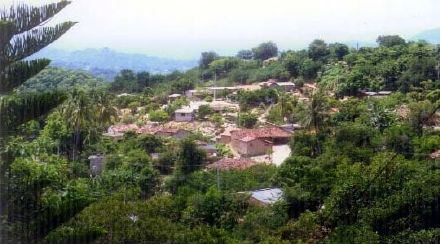 Fri 5, 12
Fri 5, 12
Fiesta of Fandango
San Pedro Tututepec
On the first Friday of October this quiet hilltop town holds a fiesta in
which Fandango, a variatio of the chilena music, that is typical of the
coastal region of Oaxaca.
A traditional 8-man band plays and the population dances from midday until dawn. The fiesta mayordomo (sponsor) provides food and drink for all-comers.
The party is repeated on the following Friday (Fri. 12), then a week later (Fri 19) in early evening the mayordomo for next year's fiesta receives the religious icon representing Las Animas, in whose honor the fiesta is held.
San Pedro Tututepec is an ancient town that this year celebrated its 1,644th anniversary. It was the center of a powerful Mixtec dynasty that dominated the region up until the time of the Conquest. Also known as Villa de Melchior Ocampo Tututepec. it was at one time the capital of the state of Oaxaca. It is an hour and a half drive from Puerto, 8 Km. (paved) off the Coast Highway just beyond Santa Rosa de Lima in the direction of Acapulco.
Sun 7
Municipal Elections
Oaxacans go to the polls today to choose their municipal presidents for
a three-year term. This means that the "Dry Law" is in effect. Alcohol
cannot be sold or served in commercial establishments from midnight on
Friday until midnight Sunday, You have been warned.
Fri 12
Columbus Day/Day of the Race
Forget Columbus Day and the Discovery of America, the Indians know it
wasn't missing in the first place. This national holiday (banks and
government offices will be closed) is less Eurocentric and acknowledges
the racial reality here. The arrival of the Spaniards was disastrous for
the indigenous peoples, but it did give birth to the mestizos, a new
race that is most representative of Mexico today.
For the record, at dawn on Oct. 12, 1492, after 70 days at sea, the crews of the caravels La Pinta, La Nina and La Santa MarÍa were alerted by the cry of "¡Tierra, Tierra, Tierra!" by seaman Rodrigo de Triano when he sighted land.
And the rest, as they say, is history. The arrival of Columbus in America was probably the transcendent event of the 15th Century.
This is an official holiday, with banks and government offices closed.
Fri 12
Fiesta of Fandango
San Pedro Tututepec
See Fri 5
Mon 15

Preparation for Day of the Dead
In coastal communities it is customary for families to visit the
cemeteries to clean the grave sites and leave small offerings to invite
the souls of the departed to return for the upcoming Day of the Dead
festivities. It signals the beginning of preparations for one of the
most colorful and enjoyable holidays of the year.
(See the story below)
Tue 18
New Moon in Libra at 2:24 p..m.
Sat 20
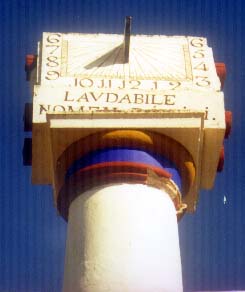
Chilena Festival
Santiago Jamiltepec
A competition that attracts musicians from all over the coast. Chilena
music is the musical sound track of the coast of Oaxacan and Guerrero
heard at all religious, civic or private celebrations, most frequently
played by a brass band.
The music is much like the Chilean cuenca and some believe it was introduced here by shipwrecked Chileans either during the colonial era slave trade or the California Gold Rush. It has been firmly adopted into the culture of the Mixtec, Amuzgo and Chatinos.
Jamiltepec, an attractive Mixtec market town with great crafts, some famous clocktowers (and a mention in D. H. Lawrence's The Plumed Serpent) is 140 Km from Puerto Escondido on the Coast Highway to Acapulco.
Wed 24
United Nations Day
The organization was founded Oct. 24, 1945
Tue 30
Birthday of Francisco Madero
(1873), the "Apostle of the Mexican Revolution and Agustin Lara
(1897 or 1900, the biographies differ) the illustrious composer.
Radio, Radio
Sunday 8 p.m. to 10 p.m.
Chiles y Chocolates, a bilingual radio program hosted by "Lucy Sonido", actually Canadian
musicologist Helena Szutska, an eclectic mix of music from around the world.
Wed. at 9 p.m.
La Luciernaga (The Firefly)
Lucy's midweek, commercial-free hour of free-flowing music. Radio Esmeralda, 94.1
FM.
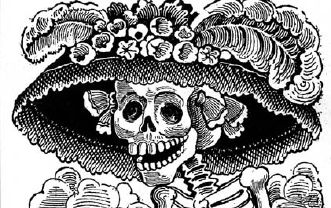 The Day of the Dead
festivities are among the most important and interesting on the entire Mexican religious calendar.
And nowhere is this celebration adopted more enthusiastically than in Oaxaca.
The Day of the Dead
festivities are among the most important and interesting on the entire Mexican religious calendar.
And nowhere is this celebration adopted more enthusiastically than in Oaxaca.
Centered around All Saints and All Souls Days on Nov. 1 and 2, preparations begin this month. Here on the coast, it is customary for local families to visit the cemeteries on Oct. 15 to clean them and leave small offerings of flowers on the graves and to issue a symbolic invitation to the spirits of the dead to return in two weeks for their special fiesta.
Towards the end of the month people flock to the markets to buy the necessary goods to build their altars and honor the dead.
There are new dishes to buy (used plates just wouldn't do to receive the spirits of the dead), the many herbs, spices and other ingredients to make the rich mole, chocolate, nuts, sweets, candy skulls, candles, incense and skeleton figures, games and toys.
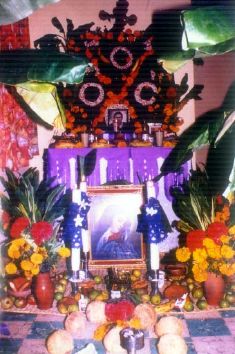 And, most importantly of all, the flowers: bright red coxcombs, white
lilies, all manner of wild flowers and especially marigolds,
cempasúchitl, the flower of the dead.
And, most importantly of all, the flowers: bright red coxcombs, white
lilies, all manner of wild flowers and especially marigolds,
cempasúchitl, the flower of the dead.
All of these will be used to decorate elaborate altars in homes, businesses and the cemeteries to welcome the spirits of the dead back to the world of the living.
The observance of All Saints and All Souls Days was initiated by Pope Gregory in the 9th century and introduced into the New World shortly after the Conquest.
It won ready acceptance because it meshed so easily with the beliefs and attitudes towards death of the indigenous people.
The cult of death was present in all of the cultures of Meso-America, nowhere stronger than among the peoples of Oaxaca. Mitla, one of the state's major archeological sites, means "place of the dead" and the pyramids of Monte Alban housed fabulous tombs filled with great treasures to accompany the departed.
In the modern era, the work of the satirist and lithographer José Guadalupe Posada, who used the skeleton motif to lambaste political figures and social injustice, created a resurgence of death imagery in popular art.
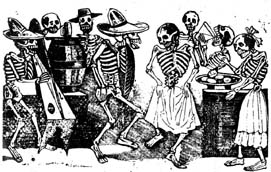 These skeleton images are called calaveras or "skulls". And they are
seen everywhere, from the political cartoons on the opinion pages of the
newspapers to children's toys and games. Calaveras is also the name for
the humorous, if macabre, poems that are composed about the untimely
demise of political leaders, friends and loved ones, even though they
may still be alive.
These skeleton images are called calaveras or "skulls". And they are
seen everywhere, from the political cartoons on the opinion pages of the
newspapers to children's toys and games. Calaveras is also the name for
the humorous, if macabre, poems that are composed about the untimely
demise of political leaders, friends and loved ones, even though they
may still be alive.
Far from being solemn or morbid, the Day of the Dead celebrations are highly festive in tone. They celebrate the continuity of life and strengthen the links to the past.
Death is the supreme equalizer; no matter how unjust the world might be, we all face the same fate. Rich or poor, ugly or beautiful, the wise and the ignorant, all, at that final hour, are destined to become bones and dust.
On the last days of the month the entire family prepares the household altar. A clean cloth is set out on a platform, arches of cane or reeds are built above it. Flowers are arranged, fruit, nuts, bowls of candy, candles and incense are laid out with photos of dead family members, religious icons and the ubiquitous, whimsical calaveras.
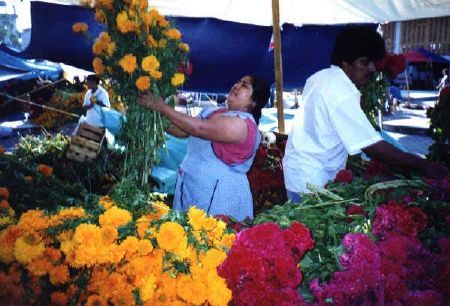 They are made of wood, ceramic or cardboard and show the dead involved
in all the activities of the living, from carousing in the cantina to
visiting the dentist. Padrecitos (little fathers) are small figurines
bearing coffins. They are made with painted garbanzo beans for heads and
painted paper robes.
They are made of wood, ceramic or cardboard and show the dead involved
in all the activities of the living, from carousing in the cantina to
visiting the dentist. Padrecitos (little fathers) are small figurines
bearing coffins. They are made with painted garbanzo beans for heads and
painted paper robes.
The altars are true works of art and proudly displayed in a place of prominence.
On the night of Oct. 30, the women work all night to prepare the special foods for the following days when first the angelitos - the souls of the children who went straight to Heaven since they were free of sin - and then the adult dead arrive to visit their families and enjoy the pleasures they once enjoyed.
It is a remarkable time to be in the state of Oaxaca, to marvel at the creativity and spiritual strength of its people.
Death is not viewed as an enemy to be feared, but as an inevitability that serves to affirm the indestructibility of the human spirit.